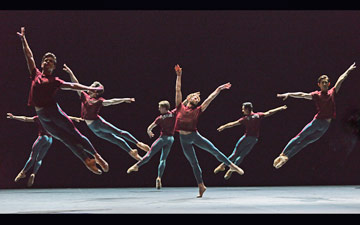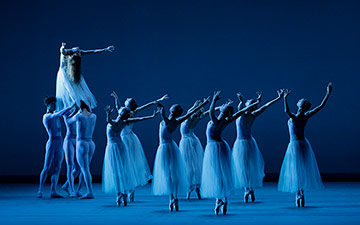
© Paul Kolnik. (Click image for larger version)
New York City Ballet
Hear The Dance – America: Hallelujah Junction, Tarantella, Interplay, Glass Pieces
New York, David H. Koch Theater
17 February 2015
www.nycballet.com
The most obvious, and pleasurable aspect of New York City Ballet’s mixed bill Hear the Dance: America is its juxtaposition of two very different works by Jerome Robbins. Separated by nearly 40 years, Interplay and Glass Pieces share some simpatico qualities, but it is the difference between them that is so gratifying – Interplay the exciting debut novel, Glass Pieces the mature masterpiece.
Interplay, dating from 1945, is Robbins’ second choreographic effort for ballet after Fancy Free. It is exactly what it says on the tin: giddy play, a game. Using a spirited, very American score by Morton Gould, Robbins sets up four men and four women in a four-part piece that is loosely competitive.
Youthful bodies skip around in cheerful, confetti-colored leotards and tights, and there’s nothing wrong with that. A field day for ballet dancers, Interplay is as much about conversations between bodies as it is about toying with ballet’s classical forms, and even its presentation – including a joke wherein the dancers “discover” the orchestra pit.
Robbins’ jazzy brio abounds in the finger snaps, flexed hands, fancy footwork and high kicks. The cast – all corps members but for soloist Brittany Pollack – felt a little embryonic on Tuesday night. Some were late and others were slippery, just barely getting through Robbins’ tricky stunts. Interplay‘s breezy, playful nature belies its difficulty level, which is high. But the yellow-clad Lydia Wellington was unflustered, standing out for her on-target musicality and unflappable ease.
Glass Pieces is another beast altogether. Utterly serious, Glass Pieces boasts a special dichotomy: that it is simultaneously dated and timeless. Dated in the sense that it is so obviously early 1980s with its bright blanched lighting, graph paper backdrop, and its music – excerpts from Philip Glass’s “Glassworks” and “Akhnaten.” But being datable is no crime, and Glass Pieces looks like a fresh cut diamond every time.

© Paul Kolnik. (Click image for larger version)
When the curtain lifts on Rubric, the first movement, the bodies are already pacing. Looking like a cross section of an underground station at rush hour, Rubric sees all the dancers marching forward at their own focused, determined pace – some slouched, some straight-backed, all eyes blank, the personal interaction nonexistent. Robbins’ ingenious movement patterns and the variety of gaits, postures and body types makes Rubric a feast for people-watchers and a mesmerizing tableau. Among the male dancers, Russell Janzen moved with the most command and intent across Glass Pieces, something immediately evident even among the planned chaos of Rubric.
Facades is no less hypnotic, though it is more pensive. A long line of bunheads bobble softly out of the upstage wing, their black silhouettes creating a soft, rhythmic and slightly alien presence against the cobalt backdrop. The ensuing pas de deux, starring Maria Kowroski and Adrian Danchig-Waring on Tuesday night, is one of Robbins’ finest. The “play ball” gesture, so whimsical and sporting in works like Interplay, here is slowed down to molasses pace. Kowroski’s legs, angled so precisely in each lift, appear frozen in time, architectural. Her arabesques are straight as arrows, her grip absolute. The contrast between the post-modern goddess’ solidity and her rippling combre back is intoxicating. Musically Facades is haunted, and when the spectral conga line ceases to regenerate and the last shadowed body exits the stage, you feel a sense of an ending, despite the infinite continuum its presence imbued.
While Glass Pieces’ separate movements feel flawless together, there is the sense that they exist independently of one another, each section being performed ad infinitum in the dance ether somewhere, an attribute that arrives not only out of Glass’s neurotic score but Robbins’ uncanny ability to make sense of it through dance.
The casting for Balanchine’s Tarantella, a cheerful “Neopolitan” pas de deux, was not the best on Tuesday night. Rather than having movement radiate from around the spine or through the plumb line, corps member Claire Von Enck moves as if her neck is the center of her body, and looks visibly strained despite her perky visage. En pointe she has the look of a fawn trying to walk, her legs not appearing strong enough for even a very petit allegro. Her partner, Spartak Hoxha was enthusiastic and zippy, with good jumps but overall lacked the final polish.

© Paul Kolnik. (Click image for larger version)
Peter Martins’ Hallelujah Junction – set with two pianists onstage playing John Adams’ score of the same name – is an abstract work in the Balanchine vocabulary, with the expected flexed hands, thrusting hips and pointe pulses into the stage. The largely en face work has few places to hide, but that did not in the least intimidate Daniel Ulbricht whose pirouettes were eye-poppingly perfect on Tuesday. Lauren Lovette was also looking on form. A rather heady musical exercise between Ulbricht and Gonzalo Garcia, wherein they use grand allegro steps to imitate closely-timed repetitions in the score, is dizzying but gratifying to watch. The challenge is to adhere to the music and not fall in sync with one another, which must do a number on their peripheral vision.

















You must be logged in to post a comment.